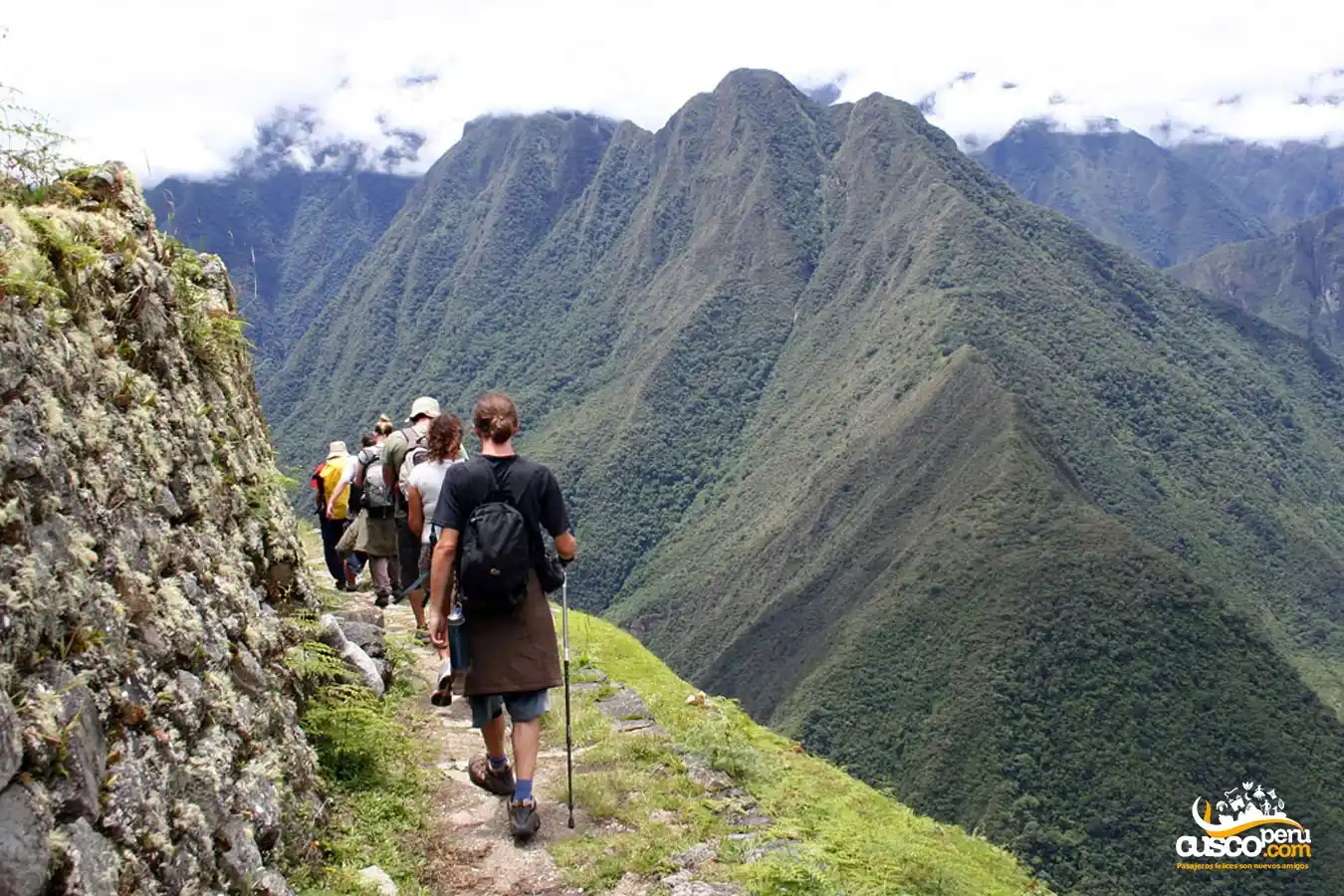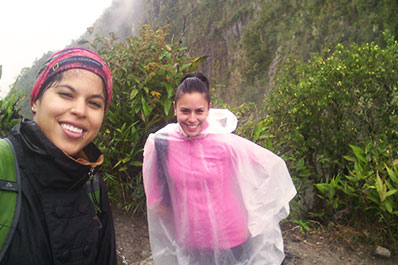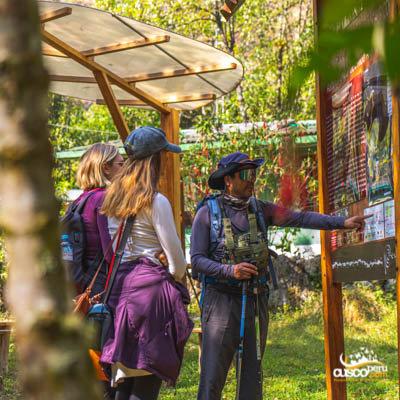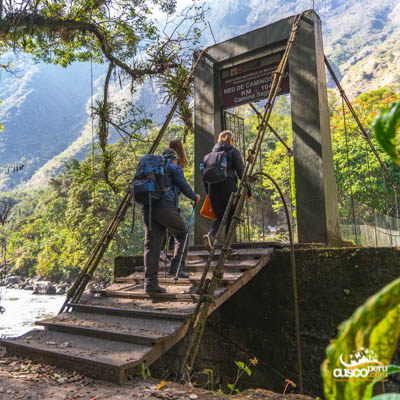
The Inca Trail to Machu Picchu is a trekking route built by the Inca Empire over 500 years ago that ends at the famous citadel of Machu Picchu. Along the route, countless Inca archaeological remains can be found, such as towers, water fountains, terraces, observatories, temples, houses, and the Inca Trail itself, whose roads or paths are built with stone.
It is considered one of the best short treks or hikes in the world.
The total extension of the Inca Trail is approximately 43 kilometers or 26.12 miles. This route has sections where extensive stairways must be climbed, as well as steep hills descended, so the route is almost never linear or straight.
The duration of the journey on the Inca Trail depends on the distance between the camping sites assigned by the INC (National Institute of Culture of Peru, the organization in charge of maintaining this route) and the physical condition of the traveler. Normally, between five to eight hours of walking are scheduled for the first three days, and two to three hours of walking on the fourth day.
Porters carry the shared luggage of the trekking group, meaning they carry tents, blankets, food, stoves, utensils, and other items that will probably be used during the journey by all participants.
Each traveler must carry their own backpack with personal use products, water, sunscreen, hats, walking sticks, rain ponchos, etc., up to a maximum of five kilos. This will be checked at the start of the journey (backpacks will be weighed to verify they do not exceed five kg).
Most of the route is made on the path made by the Incas, which is a roadway or path from 1.5 to 15 meters wide, so there are no great dangers if caution is exercised; however, one should not leave the path because there are also deep chasms that are likely fatal.
In general, the route is not dangerous, as it is correctly signposted and with safety measures, in addition to there being park rangers prepared to assist travelers.
If you have heart problems or conditions that require immediate medical assistance, you should consult with your doctor because one of the main characteristics of the route is its inaccessibility.
Along the route, bathrooms have been established, and many of them are equipped with water facilities, although most are ‘pit’ toilets, which is basically a hole in the ground with a small room installed for the bathroom.
The INC (National Institute of Culture of Peru) has designated specific areas where tourism agencies and operators, through their official guides, set up their campsites for overnight stays. The traveler only needs to take care of their belongings.
The Inca Trail does not require any special skills, meaning you do not need to know how to climb, rappel, and the like, so any traveler with good boots and proper gear can undertake it.
However, on the first day of the journey, you walk from 2,000 meters (6,561 feet) in elevation to 4,000 meters (13,123 feet), so the physical challenge is considered moderate to intense, requiring adequate physical condition. Having a good physical condition will make the journey easier.
Over the four days of hiking through impressive mountain ranges, valleys, and plains, the Inca Trail concludes at the Inca citadel of Machu Picchu, the perfect end to an unforgettable experience.
The final stretch of the Inca Trail ends at the archaeological site ‘Inti Punku’ or Sun Gate in Quechua, which is also part of the Machu Picchu Archaeological Park. On the fourth day of the journey, you will watch the sunrise through the Intipunku making this experience wonderful.
The maximum number of tourists or travelers allowed per group is sixteen people, while the minimum group size allowed is four people.
If tickets or slots are not available to undertake the Inca Trail, several alternatives can be chosen, among which are:
Since 2001, it is not possible to do the Inca Trail without the company of an official tour guide.
It is mandatory to do the Inca Trail in the company of a group of travelers led by an official tour guide, who, in turn, is controlled by the tourism agency or operator.
There are no restrictions regarding the minimum age to undertake the Inca Trail; if the child is accustomed to walking long stretches, they can perform this trekking route. However, it would be prudent to communicate and coordinate their entry with the tourism agency.
It is generally recommended that hikers pace themselves; often, there will be groups that complete the journey before others, as well as groups that overtake others and then fall behind, so there is no reason to become overly agitated.
Official tour guides are trained to handle all kinds of situations, from altitude sickness, fatigue to falls, bumps, and sprains. They will do everything possible for you to conclude your journey without problems, but if necessary, they will be responsible for coordinating your return.
It is recommended to carry at least two liters of water per day. The tourism agencies or operators are in charge of providing travelers with this vital element; however, it is also necessary to carry water purification tablets to be able to replenish water bottles at any of the multiple sources along the route.
Most hotels and hostels in Cusco have specific places for travelers to leave their luggage while they are on tour.
You can carry up to five kilos of luggage and a small backpack to carry the camera and other personal use objects.
You can climb to the top of the Huayna Picchu mountain at the end of the Inca Trail, but it must be taken into account that the tickets or entrance tickets to this mountain must be reserved three or four months in advance.
All meals (breakfast, lunch, and dinner); as well as the transportation of pots, ingredients, and other items necessary for their preparation, are the responsibility of the tour operator or tourism agency.
Yes, it is possible to request that a vegetarian option be included during the journey. This must be requested at the time of booking the tour.
Yes, in the case of having any type of dietary restriction, such as allergies, being lactose intolerant, or having allergies to certain foods, the menu can be accommodated to your preferences.
To embark on your journey through the Inca Trail, here are the essential elements to consider:
You need to be prepared for this incredible trekking; you should have the appropriate clothing for temperature variations throughout the day and night.
The Inca Trail is one of the most famous trekking routes in the world, and tickets for entry sell out many months in advance, with only 200 tickets available per day.
It is recommended to make the reservation as far in advance as possible, typically this should be more than six months.
To secure the booking of the Inca Trail ticket, a deposit of 40% of the total cost is required.
The entrance tickets to the Inca Trail are managed by the INC, so it is not possible to return the money once the deposit has been made.
No, the Inca Trail is closed in February due to maintenance and prevention work, in addition to being the rainy season.
During the first two days of the journey, you will traverse plains and ascend to very high peaks, so altitude sickness can indeed be a concern. It is advisable to carry medication to counteract its effects.
From April to November is the dry season, during which significant precipitation does not occur. From December to March is the rainy season, accompanied by landslides, road closures, and many other unforeseen events.
The best time to hike the Inca Trail is from May to August, as this period is the dry season when there are no rains, making the journey easier and less hazardous.
You should wear clothing suitable for both cold and hot weather, as the first part of the route is done in cold climates and at high altitudes, while at the end of the journey you will find yourself in the midst of a warm subtropical jungle, full of vegetation, humidity, and heat.
You should carry a sleeping bag, also called a sleeping, a tent, a raincoat, a towel, a flashlight, a hat, toilet paper, among other items. Most of the logistics of the trip are handled by the tourism agency or operator.
It is recommended to wear worn hiking shoes or boots. The drawback is that if the footwear chosen is new or recently purchased, it usually causes injuries or blisters on the foot after one or two days of hiking.


